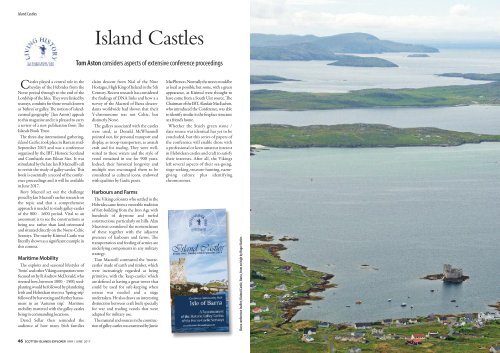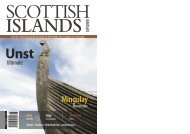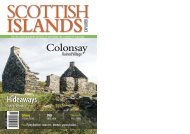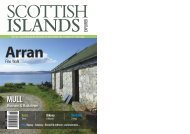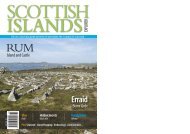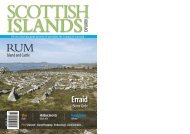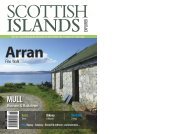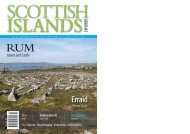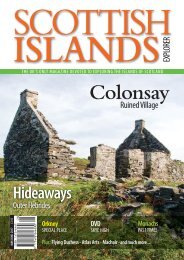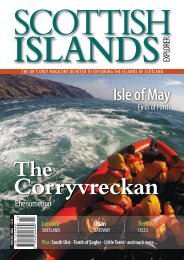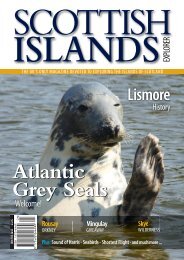You also want an ePaper? Increase the reach of your titles
YUMPU automatically turns print PDFs into web optimized ePapers that Google loves.
Island Castles<br />
Island Castles<br />
Tom Aston considers aspects of extensive conference proceedings<br />
Castles played a central role in the<br />
heyday of the Hebrides from the<br />
Norse period through to the end of the<br />
Lordship of the Isles. They were linked by<br />
seaways, conduits for those vessels known<br />
as ‘birlinn’ or galley. The notion of ‘islandcentred<br />
geography’ (Ian Armit) appeals<br />
to this magazine and it is pleased to carry<br />
a review of a new publication from The<br />
Islands Book Trust.<br />
The three-day international gathering,<br />
Island Castles, took place in Barra in mid-<br />
September 2015 and was a conference<br />
organised by the IBT, Historic Scotland<br />
and Comhairle nan Eilean Siar. It was<br />
stimulated by the late Ian R Macneill’s call<br />
to revisit the study of galley-castles. This<br />
book is essentially a record of the conference<br />
proceedings and it will be available<br />
in <strong>June</strong> <strong>2017</strong>.<br />
Rory Macneil set out the challenge<br />
posed by Ian Macneil’s earlier research on<br />
the topic and that a comprehensive<br />
approach is needed to study galley-castles<br />
of the 800 - 1600 period. Vital to an<br />
assessment is to see the constructions as<br />
being sea- rather than land-orientated<br />
and situated directly on the Norse-Celtic<br />
Seaways. The nearby Kisimul Castle was<br />
literally shown as a significant example in<br />
this context.<br />
Maritime Mobility<br />
The exploits and seasonal lifestyles of<br />
‘Svein’ and other Viking compatriots were<br />
focused on by R Andrew McDonald, who<br />
stressed how, between 1000 - 1500, seedplanting<br />
would be followed by plundering<br />
Irish and Hebridean sites in a ‘Spring-trip’<br />
followed by harvesting and further harassment<br />
in an ‘Autumn trip’. Maritime<br />
mobility mattered with the galley-castles<br />
being in commanding locations.<br />
David Sellar then reminded the<br />
audience of how many Irish families<br />
claim descent from Nial of the Nine<br />
Hostages, High King of Ireland in the 5th<br />
Century. Recent research has considered<br />
the findings of DNA links and how a a<br />
survey of the Macneil of Barra descendants<br />
worldwide had shown that their<br />
Y-chromosome was not Celtic, but<br />
distinctly Norse.<br />
The galleys associated with the castles<br />
were used, as Donald McWhannell<br />
pointed out, for personal transport and<br />
display, as troop-transporters, as assault<br />
craft and for trading. They were wellsuited<br />
to these waters and the style of<br />
vessel remained in use for 900 years.<br />
Indeed, their historical longevity and<br />
multiple uses encouraged them to be<br />
considered as cultural icons, endowed<br />
with qualities by Gaelic poets.<br />
Harbours and Farms<br />
The Viking colonists who settled in the<br />
Hebrides came from a venerable tradition<br />
of fort-building from the Iron Age with<br />
hundreds of drystone and turfed<br />
constructions, particularly on hills. Alan<br />
Macniven considered the nomenclature<br />
of these together with the adjacent<br />
presence of harbours and farms. The<br />
transportation and feeding of armies are<br />
underlying components in any military<br />
strategy.<br />
Tom Macneill contrasted the ‘mottecastles’<br />
made of earth and timber, which<br />
were increasingly regarded as being<br />
primitive, with the ‘keep-castles’ which<br />
are defined as having a great tower that<br />
could be used for safe-keeping when<br />
retreat was needed and a siege<br />
undertaken. He also draws an interesting<br />
distinction between craft built specially<br />
for war and trading vessels that were<br />
adapted for military use.<br />
The material and sources in the construction<br />
of galley-castles was examined by Jamie<br />
MacPherson. Normally the stones would be<br />
as local as possible, but some, with a green<br />
appearance, at Kisimul were thought to<br />
have come from a South Uist source. The<br />
Chairman of the IBT, Alasdair MacEachen,<br />
who introduced the Conference, was able<br />
to identify similar in the fireplace structure<br />
at a friend’s home.<br />
Whether the Stuely green stone /<br />
slate source was identical has yet to be<br />
concluded, but this series of papers of<br />
the conference will enable those with<br />
a professional or keen amateur interest<br />
in Hebridean castles and craft to satisfy<br />
their interests. After all, the Vikings<br />
left several aspects of their sea-going,<br />
siege-seeking, treasure-hunting, namegiving<br />
culture plus identifying<br />
chromosomes.<br />
Barra conference leaflet; Kisimul Castle, Barra, from on high by Roger Butler.<br />
46 SCOTTISH ISLANDS EXPLORER MAY / JUNE <strong>2017</strong>


